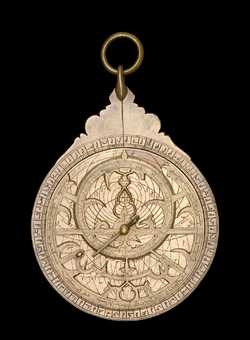Astrolabes / Browse
/ 51182
| Date | 1505/06 (A.H. 911) |
| Maker | Muḥammad Ṣaffār |
| Place | Persia |
| Material | Brass |
| Inventory no. | 51182 |
| Acquisition | Presented by J. A. Billmeir in 1957 |
View all
images for this astrolabe
View
detailed provenance for this astrolabe
Mater
The mater and limb are of one-piece construction. The plates are held in place by a post located on the meridian line, just above the bottom of the instrument. Scales on the limb: degree scale. More informationBack
The back contains 0 scales. The back is inscribed: with a maker's signature marked as هذه الاصطرلاب العبد الفقير الى الله الغفار في سنة تسع ماية احدى عشر شمس الدين محمد صفار (Of this astrolabe the servant in need of God the forgiving, Shams ad-Dīn Muḥammad Ṣaffār in the year nine hundred and eleven.). Lower half of back. with a scale label marked as ظل الأصابع عمد ظل الأقدام مديد (The shadow of the fingers is vertical / The shadow of the feet is extended.). Upside down within the shadow square. More informationRete, Pin & Horse
The rete contains 0 stars. The rete contains zoomorphs: the star pointer for vega is a small birdThe rete is attached using a pin & horse. The pin is far too long, suggesting that this is a later replacement. It is also possible that the horse is a replacement, for a thicker horse would take up the slack in the pin. More information
Rules & Alidades
| Type | Details |
|---|---|
| Alidade | Double-ended. The alidade is quite unusual by being
constructed out of two intersecting rules. One is curved
slightly and has a single sighting vane. The other is
more typical, straight and with two sighting
vanes. |



